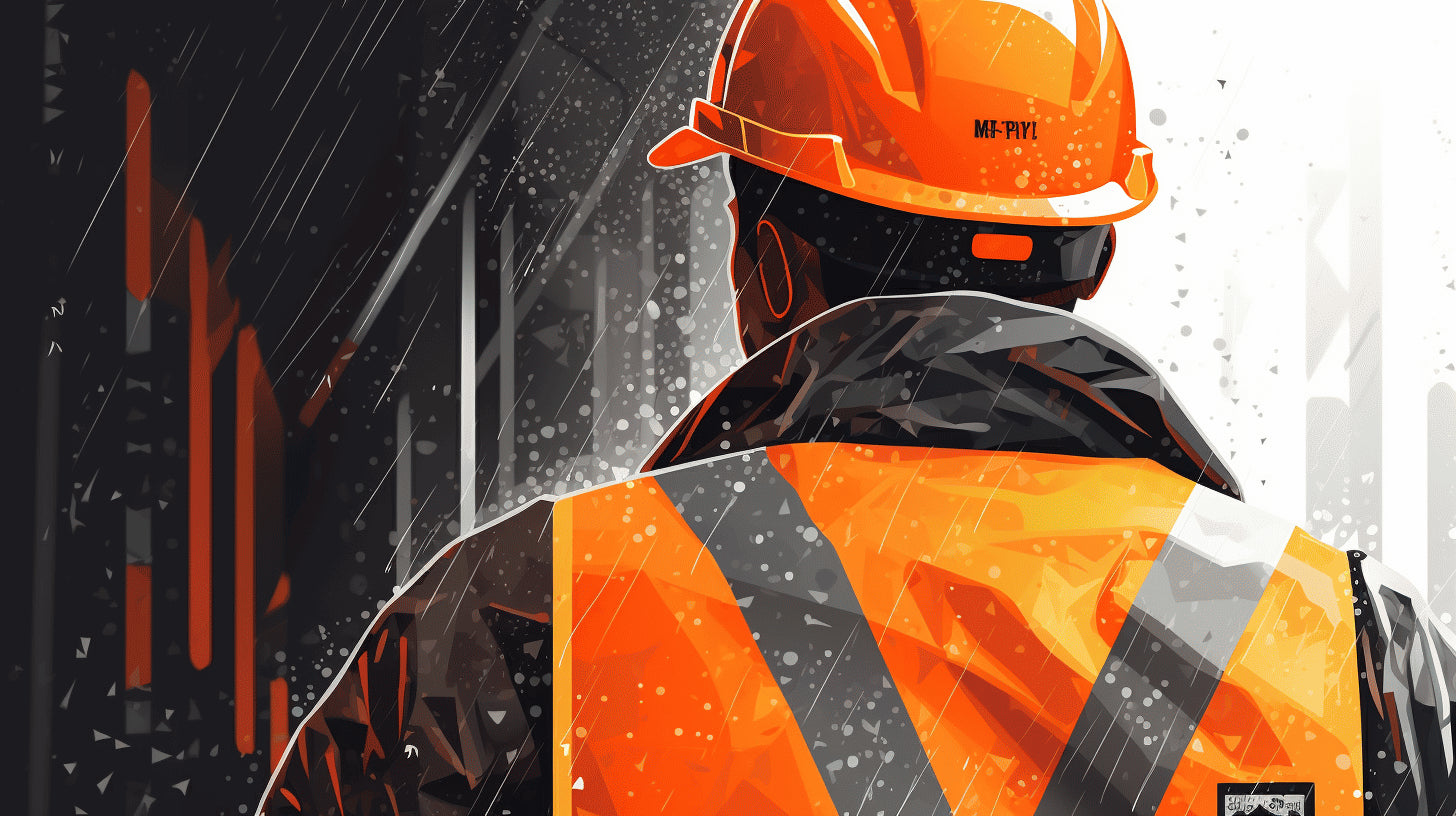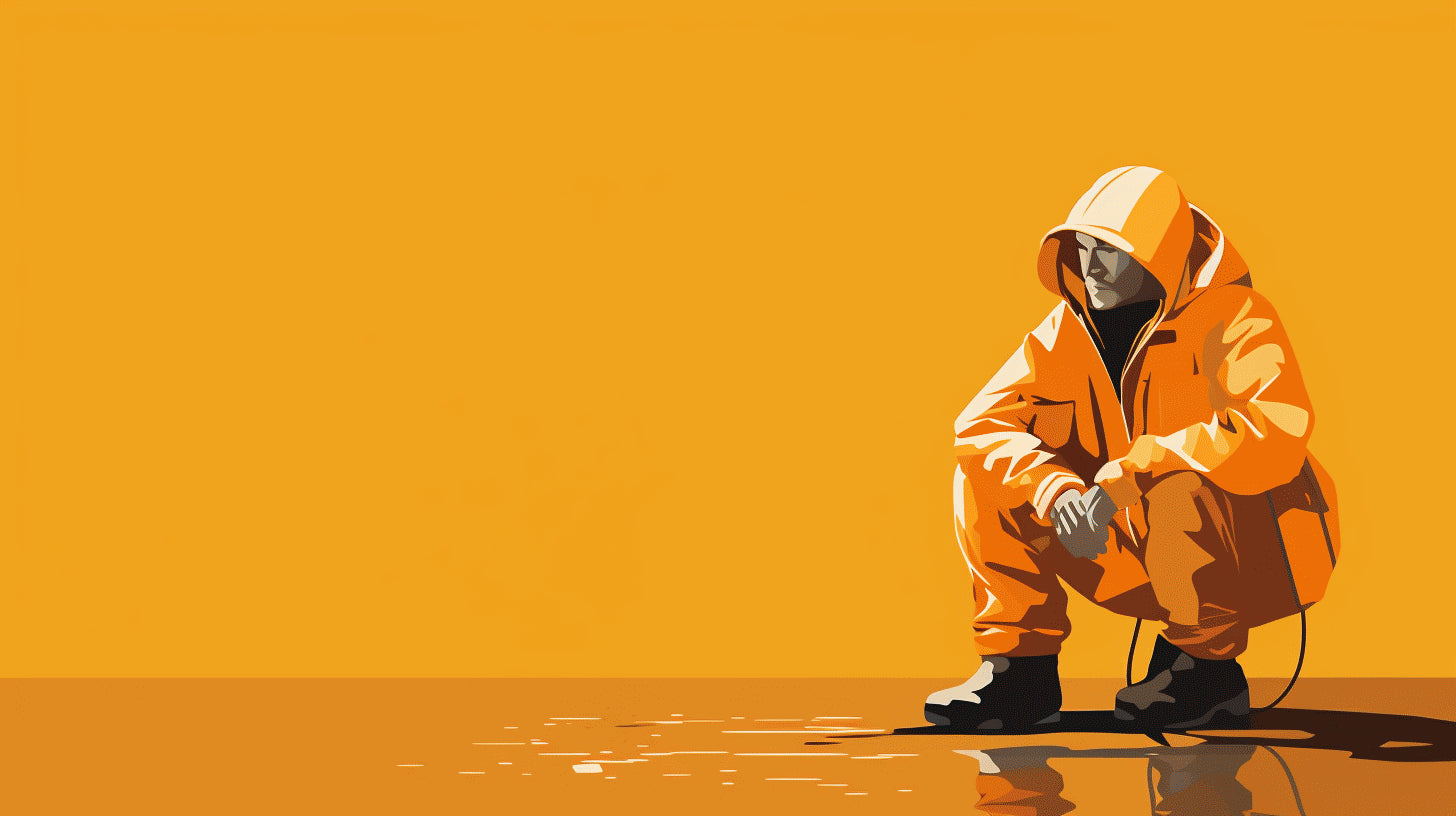Whether it's a mild drizzle or a torrential downpour, rain presents a unique set of challenges to workers in the construction industry. Their work, often carried out outdoors or in partially complete structures, leaves them at the mercy of weather conditions. Over time, the need for protective gear, specifically rain gear, has become more substantial.
In this article, we delve deep into the rising trends in rain gear for construction workers in 2023, highlighting their importance, the current standards, the impactful trends, and the anticipated developments in the near future. We evaluate how these factors are reshaping the construction industry, creating safer working conditions, and boosting worker satisfaction and productivity. Gear up for a riveting exploration, and level up your knowledge on the subject!
Importance of Rain Gear for Construction Workers
Heavy rain can be a serious hurdle in the construction field, turning a regular day’s work into a perilous one. It's here that the role of rain gear comes into play, and this article aims to shed light on the importance of rain gear for construction workers. Substantial rain gear doesn't just ensure the safety of the workers but also guarantees a consistent workflow, maintaining the productivity of the construction site.
Safety Procedures
Workplace safety is paramount in any industry, and the construction industry is no exception. The use of proper rain gear is a significant element in safety procedures, especially during the monsoon season or in regions where rain is a frequent occurrence. The priorities of security measures are twofold:
- Prevention of Accidents: Certain types of rain gear, such as water-proof boots, help prevent slipping and falling on slick, drenched surfaces. Similarly, raincoats and ponchos can protect workers from chill and dampness, keeping them agile and alert.
- Visibility Enhancement: Construction rain gear often comes designed with high-visibility colors and reflective materials. This feature makes the worker easily noticeable even in heavy rain, minimizing risks associated with low-visibility conditions.
Prolonged Productivity
Just as significant the safety measures, rain gear also helps maintain productivity in a rainy environment. Here’s how:
- Continuity of Work: With adequate rain gear, workers can continue their operations despite the rain, ensuring the project adheres to deadlines.
- Equipment Protection: Well-designed rain gear can also provide some level of protection to the equipment used on-site, preventing rust, electric shock, and other damage.
Health Protection
Lastly, the role of rain gear in ensuring the health and wellness of construction workers is irreplaceable. Continuous exposure to rain and moisture may lead to health issues like cold, flu, pneumonia, and skin irritations. By using rain gear, workers can shield themselves from these potential health risks, ensuring they're fit and well to accomplish their tasks.
In conclusion, rain gear is quite literally an umbrella of safety and productivity for construction workers. Its importance is not just confined to the workers who are directly exposed to the rain, but also extends to the project's overall success. Therefore, this investment should be viewed not as a choice but as a necessity for every construction site.
Current Standards in Rain Gear for Construction Workers
As awe-inspiring as it is to see skyscrapers touch the clouds, it's easy to overlook the sheer grit and determination of construction workers who carry on, come rain or shine. In particular, the rain gear they use isn't just about comfort - it's an essential gear that meets industry standards and regulations for safety. This section will delve into the current standards in rain gear used by construction workers, focusing on three key areas: commonly-used materials, prevalent designs and styles, and compliance with regulatory guidelines.
Materials Commonly Used
While there's a certain romanticism to traditional raincoats made with rubber or oilcloth, construction rain gear has evolved to use advanced materials that balance waterproof capabilities with breathability, durability, and overall comfort. Let's break down the popular choices:
- Polyester – Treated with a waterproof coating, polyester is lightweight yet robust enough to resist tears and snags, making it a top choice for construction rain gear.
- Nylon – Known for its excellent durability, nylon is also coated to make it waterproof. A key advantage lies in its lightweight nature, adding to the comfort factor.
- Gore-Tex – This one's the peak performance gear on the list. Gore-Tex is essentially waterproof but manages to allow internal moisture (think perspiration) to escape, helping maintain comfort and breathability during demanding physical tasks.
Common Designs and Styles
As varied as the construction projects themselves, rain gear designed for workers is not a one-size-fits-all solution. You'll find a spectrum of designs tailored to different needs:
- Full-body suits – Much like a hazmat suite, the full-body rain suit envelops the user completely, effectively blocking the rain. The downside? They can be slightly cumbersome to move in.
- Separate Jackets and Pants Sets – A versatile duo that offers flexibility and comfort. The jacket can be worn separately on drizzly days, while the pants can be added when the downpour intensifies.
- Poncho-style raincoats – A breeze to throw on or take off, they offer a balanced compromise of comfort and ease of use. However, their loose fit may not appeal to everyone.
Regulatory Compliance
Making sure rain gear meets safety regulations isn't merely a matter of ticking off boxes on a checklist. It directly impacts the safety and wellbeing of construction workers. Standards typically cover aspects such as visibility (reflective strips are a common feature), heat insulation, and resistance to chemicals or flames.
Notably, rain gear should satisfy standards set by bodies like the Occupational Safety and Health Administration (OSHA) and the American National Standards Institute (ANSI). These ensure that the gear is not just about staying dry, but about having a protective shield in challenging work environments.
As we can see, rain gear for construction workers is a blend of science, design, and vital safety regulations. The glistening cities and sprawling infrastructure we see around are, in many ways, a testament to the unsung heroes who labor in the rain in their gear, building the future even as the skies are grey.
Trends in Rain Gear for Construction Workers
As construction projects continue to demand on-time completion, irrespective of weather conditions, there's an increasing reliance on safety gear, particularly rainwear. From head-to-toe protection, durable materials, and conscientious sustainability practices, the trends in rain gear for construction workers tell an interesting story of design meeting practicality. Today, we'll delve into four compelling trends in the space of construction rainwear.
Use of Advanced Materials
In the past, rain gear fabric choices were restricted to stiff and cumbersome materials that did little more than protect against water. However, today's innovations in textile technology have forever transformed this landscape. Technical fabrics like Gore-Tex and Tyvek have made it possible for rainwear to be both waterproof and breathable, an essential attribute for those toiling under strenuous, moist conditions. These materials don't just keep the rain out; they wick away sweat, making them indispensable to construction workers.
Emphasis on Comfort
Recent years have witnessed an industry-wide emphasis on comfort, as it directly impacts the user's productivity. Construction gear manufacturers now prioritize ergonomics, designing rainwear that's flexible, lightweight, and easy to work in without restriction. Some advanced rain gear options also feature adjustable components, making it possible to tailor the fit to the user's size and preference. This personalized fit boasts of additional benefits like enhanced mobility, decreased fatigue, and increased job satisfaction.
Sustainability and Eco-friendliness
The construction industry, historically spotlighted for its environmental impact, has been taking strides towards incorporating sustainability into every facet, including worker's gear. More and more manufacturers are creating rain gear from recycled materials or designing them for reusability. The drive towards eco-friendliness is not just about minimizing ecological footprints; it's also about creating a green and future-focused corporate image that appeals to increasingly environmentally conscious clientele.
Increased Visibility and Safety Features
Capturing the most significant trend in construction rain gear is the brilliant and increased visibility coupled with additional safety features. Available are rainwear with high-visibility colors and reflective strips, designed to maximize worker visibility on potentially dangerous worksites, or when working at night. Safety doesn't stop at being seen, however. Some rain gear even includes in-built protective elements, such as reinforced elbows and knees, or padding in critical impact zones, going the extra mile for worker safety.
From advances in fabric technology and prioritizing comfort, to sustainability practices and safety-conscious designs, the evolution of rain gear for construction workers is a testament to the industry's effort in facing modern-day challenges head-on. As these trends continue to unfold, one thing remains certain: They're not just about weathering the storm, they're about enabling construction workers to do their jobs comfortably, safely, and conscientiously.
Impact of Trends on the Construction Industry
The construction industry is an ever-evolving landscape, inhabited by unceasing innovations, progressive technologies, and trending practices that noticeably impact its facets - be it the workforce, site safety, productivity or job satisfaction. Let's delve deeper into the ways this industry has been influenced, and continues to be shaped, by the transpiring trends.
Improvement in Safety
Unsurprisingly, the priority of safety has always remained supreme on a construction site. However, the current trends paint a picture of how vital technology has become in ensuring that safety. Incorporating advanced equipment and innovative instruments, such as wearables and drones, has led to increased urbanization and reduced workplace accidents drastically. Here's how:
- Wearables: From smart hard hats to safety goggles integrated with augmented reality, wearables are providing real-time information, thereby making it easier to mitigate risks and respond to onsite emergencies swiftly.
- Drones: These flying devices can reach areas of the site that are otherwise difficult or dangerous for workers, performing inspections, monitoring processes, and ensuring that safety parameters are fully met at all times.
Tagging along with these are improved training methods, such as virtual reality, which are being used to acclimatize workers to critical safety scenarios that might take place on the work ground. The results of such tech-inspired safety measures have been quite gratifying so far, with significant reductions in onsite injuries reported across the globe.
Boost in Productivity
Aside from safety, the other tangible benefit of the ongoing trends has been the noticeable uptick in productivity. The advent of digital systems, coupled with AI-powered solutions, has engineered a plethora of benefits, including:
- Advanced Machines: From 3D printers to automated robots, these machines have eased the workload, enabled precision, and remarkably reduced construction timelines.
- Project Management Tools: These digital platforms help in keeping a meticulous track of the project milestones, workforce performance, and budget management.
All these factors contribute to the productive growth of the industry, reducing delays and surpassing expectations.
Enhanced Worker Satisfaction
The beating heart of the construction industry has always been its workforce. If the employees are satisfied, it turns a positive wheel of productivity and reputation. The trending practices in the industry are noticeably enhancing worker satisfaction:
- Career Development: With advancements in technology, employees have opportunities to uplift their skills, leading to growth and job security.
- Improved Working Conditions: Thanks to technological advancements, strenuous tasks are mechanized, reducing physical fatigue and health risks.
All in all, the impact of these trends on the construction industry is undeniably transformative. Gone are the days when construction was just about bricks and mortar. The industry has become a canvas where new technologies merge with traditional methods to create safer, more efficient, and satisfactory work environments. As we step into the future, we can confidently anticipate an era of increased growth and unprecedented developments in the field.
Expected Developments in Rain Gear for 2023
As we stand on the precipice of technological advancement and innovative designs, the world of rain gear isn't exempt from the wave of change. The year 2023 brings with it unparalleled forecasts regarding material advancements, design improvements, and regulatory changes set to revolutionize your wet weather gear.
Predicted Material Advancements
One of the most thrilling aspects of the future of rain gear is the expected material advancements. The industry has long been utilizing waterproof materials like Gore-Tex and waxed cotton, but the year 2023 promises something different.
- Nanotechnology Infused Fabric: Nanotech is predicted to weave its magic into the fabric of rain gear, making them more waterproof, breathable, and lighter without compromising on durability.
- Eco-friendly Waterproofing: With the mounting pressure to limit environmental footprint, a shift towards sustainable, bio-based waterproofing methods is anticipated.
- Heated Jackets: Further afield, we could see the integration of smart technology, with heated jackets becoming a new standard in fighting against cold and wet climates.
Clearly, it's an exciting time for the development of rain gear materials.
Anticipated Design Improvements
Moving on from materials, let's delve into the anticipated design improvements that are due to elevate the effectiveness and style quotient of our rain gear.
- Greater Emphasis on Aesthetics: In 2023, rain gear may cast off its purely functional image with a stronger emphasis on fashion-forward designs.
- Built-in Storage: In response to urban commuters' demands, built-in storage compartments capable of protecting electronic devices could become mainstream.
- Multifunctional Apparel: Expect to see more 'convertible' rain gear that can be modified or worn in different ways according to the changes in weather.
Expected Regulatory Changes
Finally, as advancements in rain gear production charge ahead, significant regulatory changes are expected to keep pace, ensuring consumer safety and environmental sustainability.
- Stricter Environmental Regulations: The production of rain gear may face tighter controls, pushing manufacturers to take sustainable approaches including the use of recyclable materials.
- Enhanced Consumer Protection Laws: The introduction of more stringent safety standards to protect consumers from potential hazards associated with tech-integrated apparel is likely.
In a nutshell, the future of rain gear is shaping up to be inspiring and noteworthy. As we slip into the era of advanced materials and innovative designs, combined with proactive regulation, staying dry in 2023 could look quite different from what we're used to. Keep an eye on these exciting developments as they unfold; these changes will likely redefine your relationship with the rain.
Conclusion
As the adage goes, "There is no such thing as bad weather, only inappropriate clothing." This holds especially true for construction workers who are required to spend long hours exposed to the elements. With the rising trends and forthcoming advancements in rain gear for 2023, it's evident that the construction industry is progressing towards adopting gear that enhances safety, boosts productivity, and notably improves worker satisfaction.
From leveraging advanced materials to increasing visibility with features like reflective striping, these developments promise newer standards of protection and comfort for construction professionals. Not to forget, sustainability is creeping up the priority list, highlighting the industry’s awareness of environmental responsibility.
Companies like Hurricane Raingear stand at the forefront of this evolution, offering handcrafted 100% waterproof, breathable, and rip-resistant gear for any weather conditions. Their dedication to not only meeting but surpassing current trends lends credibility to the predicted advancements in the industry.
Reflecting upon these trends, it’s safe to say, the future has never looked brighter or drier, for construction professionals braving the rain. So, let's look forward to 2023 with anticipation as these predictions hunker down to become reality, setting new norms in rain gear for construction workers. Ribbon on the package? Enhanced safety, comfort, and eco-friendliness are not just trends anymore, but a standard that companies are ardently working towards.
Frequently Asked Questions
-
What are the current rising trends in rain gear for construction workers in 2023?
Some of the rising trends in rain gear for construction workers in 2023 include waterproof and breathable materials, hi-visibility designs, ergonomic fitting, multiple pocket options, and durable construction.
-
What are the benefits of using waterproof and breathable materials in rain gear?
Waterproof and breathable materials in rain gear provide protection from rain and moisture while allowing heat and sweat to escape. This helps keep construction workers dry, comfortable, and prevents overheating.
-
Why are hi-visibility designs important in rain gear for construction workers?
Hi-visibility designs in rain gear are crucial for the safety of construction workers, as they enhance visibility in low-light conditions or bad weather. This decreases the risk of accidents by making the workers more noticeable to others on the construction site.
-
How does ergonomic fitting make a difference in rain gear for construction workers?
Ergonomic fitting ensures that rain gear allows for ease of movement and flexibility without being restrictive. It enables construction workers to perform their tasks comfortably and efficiently, even in wet conditions.
-
What are the advantages of having multiple pocket options in rain gear?
Multiple pocket options in rain gear provide convenient storage for tools, personal belongings, and small equipment. This eliminates the need for additional bags or pouches, making it easier for construction workers to access essential items on the go.























Leave a comment
This site is protected by hCaptcha and the hCaptcha Privacy Policy and Terms of Service apply.